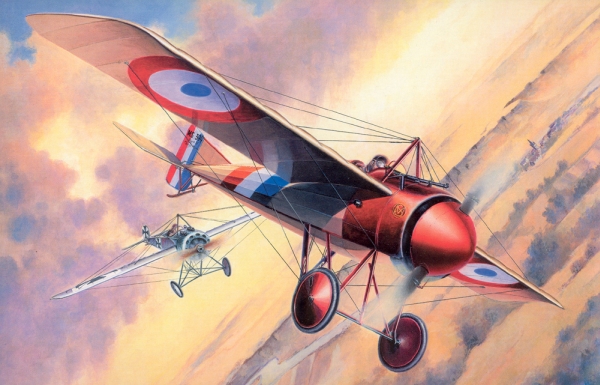

The Morane-Saulnier N, also known as the Morane-Saulnier Type N, was a French monoplane fighter aircraft of the First World War.
Designed and manufactured by Morane-Saulnier, the aircraft was presented for the first time by the pilot Roland Garros in Austria in 1914, entered service in April 1915 with the Aéronautique Militaire and was in service until the summer of 1916. It also equipped four squadrons of the Royal Flying Corps, in which it was designated the Bullet and was operated in limited numbers by the 19th Squadron of the Imperial Russian Air Force.
It was not easy to fly due to its stiff controls (using wing warping instead of ailerons) and high landing speed. Aircraft mounted a single unsynchronized forward-firing machine gun (either a 8 mm Hotchkiss or .303-in Vickers) which used the deflector wedges, in order to fire through the propeller arc. A large metal spinner designed to streamline the aircraft caused the engines to overheat because the spinner deflected air away from the engine. In 1915, the spinner was removed from the design and no more overheating problems were found. The removal of the spinner caused very little loss in performance.
The type N was built with a rather modern shape with a round cross-section and a tension pole over the fuselage in front of the open pilot's seat as well as another tension pole behind the first one under the fuselage. The whole fuselage was fabric covered. The wing assembly was constructed with a braced midwing configuration and comprised straight leading and trailing edges. The ends were chamfered forward and were fabric covered, too. The tail assembly was cantilevered and had a normal configuration with a parted elevator and a downward protruding rudder. The landing gear was formed with a continuous axle and couldn't be retracted. The aircraft had a tail skid.
The type N was not particularly successful (probably only 49 most aircraft were built) and it was quickly replaced by following designs.
More about Morane N on wikipedia
The Eduard's model (actually the new tooling, as the first attempt is dated back to 1995) comes in a box with nice image of the aircraft with the red nose, inside you find the parts made of light brown plastic, sheets of assembly instructions and colour views of two there are decals for 2 colour schemes. The quality is, I would say, very good. The instruction are in Czech and English, with pretty clear diagrams.
I
The kit offers two camouflages of French airforce, the main diference is the colour of the front part of fuselage, one is red the other black, as the black one looked to me more elegant, I decided for that.
As I described painting the model in construction part here I will describe only few things. I sprayed the whole model with glossy varnish and then I aplied the decals (I used even the black lines for the edges of the wing and elevators, but left the silver "chips"). When all was in the place, I glued the elevators, sprayed again the whole model this time with matt varnish and let it dry for few days. Last thing I did was to add little bit of dirt on the wheels and around skid.
There is a separate diagram in the instruction sheet to help with the rigging, so there was little trouble to do it, appart of to straightened the copper wire from telephone cabel I used, that looked good enough for the scale and provides additional support for the wings of this delicate model. I painted it black.
Last thing to make was the rigging. There is a separate diagram in the instruction sheet to help, so there was little trouble to do it, I used the copper wire from telephone cabel that looked good enough for the scale and provides additional support for the wings of this delicate model. I painted it black. Done. :)
Nice, neat kit, with only one nasty trick (if you remember the kit is very fragile and the best is to leave the elevator and rudder till the very end of the assembly). For the kit exists the PE that offers some possibilities for personal improvements if you wish to do such (I did not use that, as I decided to make my models out of box mainly).
June 2013